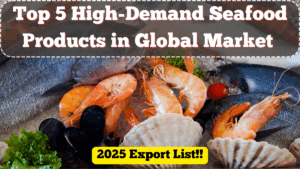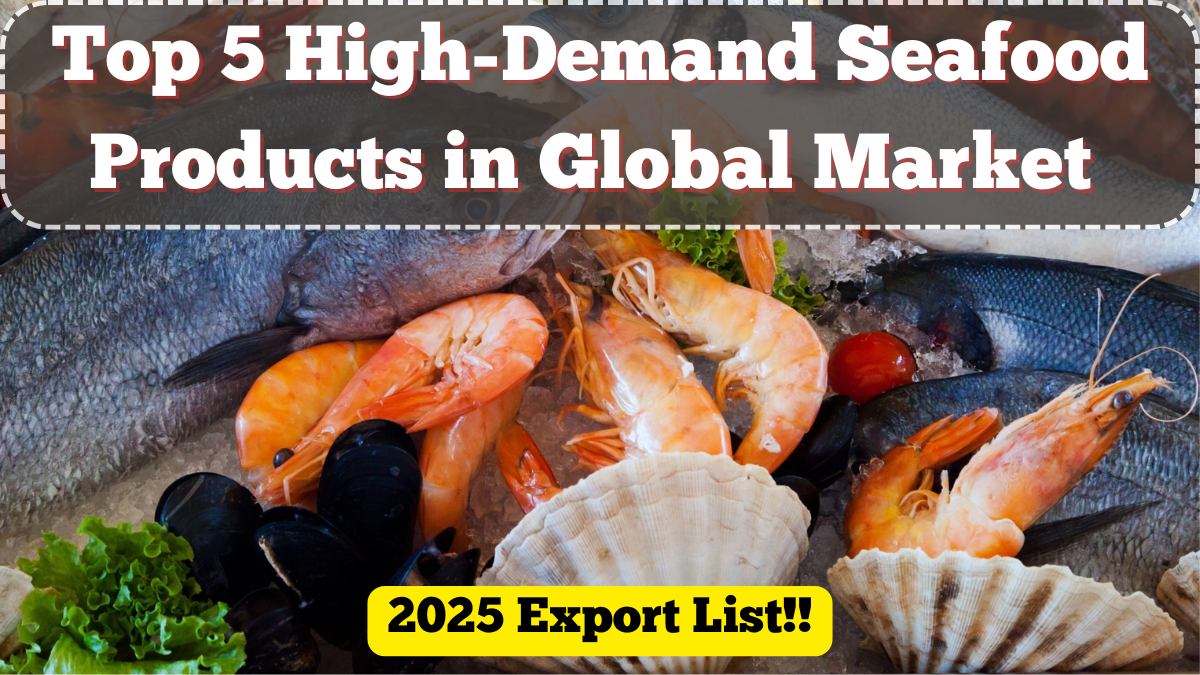India’s seafood export industry continues to thrive in 2025, with certain seafood products taking the lead in global demand. As international consumers become more health-conscious and selective about their food choices, Indian exporters are witnessing a surge in interest for high-quality, sustainably sourced marine items.
From frozen shrimp to exotic cuttlefish, Indian seafood products are being shipped in large volumes to key markets such as the US, China, Japan, and the EU. The year 2025 has seen a sharp increase in orders for certain premium items, creating new opportunities for processors and exporters across the country.
Let’s take a look at the top-performing seafood products this year.

Top 5 Most Exported Seafood Products from India in 2025
The Marine Products Export Development Authority (MPEDA) has released updated export data showing the five most in-demand seafood products from India in 2025:
| Rank | Seafood Product | Key Markets | Growth Rate (YoY) |
|---|---|---|---|
| 1 | Frozen Shrimp | USA, Japan, EU | +15% |
| 2 | Cuttlefish & Squid | South Korea, Spain | +12% |
| 3 | Frozen Tuna | UAE, Germany, Singapore | +10% |
| 4 | Dried Fish & Anchovy | Malaysia, Thailand | +8% |
| 5 | Value-Added Seafood | USA, Australia | +18% |
These seafood products account for more than 80% of India’s total marine export volume, with frozen shrimp alone contributing over 50% of the total revenue.
Why These Seafood Products Are So Popular
The rising popularity of these seafood products can be attributed to:
-
Health benefits: High protein and omega-3 content in shrimp and tuna make them a preferred choice for fitness-conscious consumers.
-
Diverse culinary uses: Indian squid and cuttlefish are prized in Mediterranean and Asian cuisines.
-
Longer shelf life: Frozen and dried seafood allows exporters to access far-off markets without compromising quality.
-
Customizable processing: Value-added items like marinated fillets, ready-to-fry shrimp, and flavored tuna chunks are catering to urban, convenience-focused buyers.
As global food preferences shift toward leaner protein options, these seafood products are becoming essential in hotels, restaurants, and home kitchens worldwide.
India’s Edge in Global Seafood Trade
India has a strategic advantage in producing and exporting these high-demand seafood products due to:
-
Vast coastline supporting aquaculture and deep-sea fishing.
-
Technologically advanced processing units in states like Andhra Pradesh and Kerala.
-
Strict adherence to global food safety standards such as HACCP, FDA, and EU norms.
-
Government incentives under the Marine Export Development Plan 2025.
Exporters are also leveraging traceability and eco-labeling to appeal to environmentally conscious buyers.
Exporter Strategies to Meet Global Demand
To meet the growing demand for these seafood products, Indian companies are:
-
Expanding shrimp farms and hatcheries to boost output.
-
Partnering with cold chain logistics providers to maintain freshness during long-distance exports.
-
Investing in automated sorting, grading, and packaging facilities.
-
Participating in global seafood expos and buyer-seller meets.
Additionally, value-added product lines are being launched with region-specific flavors to attract new demographics in North America and Europe.
Future Scope for Small and Medium Exporters
SMEs looking to enter the seafood products market can tap into the growing demand by:
-
Focusing on niche categories like organic shrimp or pre-marinated items.
-
Collaborating with aggregators for bulk export orders.
-
Selling through international B2B platforms verified by MPEDA and FSSAI.
With the right certifications and quality assurance, even small players can establish a strong export presence in 2025.
FAQs
What is the most exported seafood product from India in 2025?
Frozen shrimp remains the leading seafood product in terms of volume and revenue, especially in the US and EU markets.
Why is tuna gaining popularity in seafood exports?
Tuna is in high demand for its health benefits, versatility in recipes, and increasing popularity in Asian and Middle Eastern cuisines.
Are Indian seafood products certified for export quality?
Yes, Indian exporters follow international quality standards like HACCP, BRC, and FDA to meet the expectations of importing countries.
Is there a demand for value-added seafood in 2025?
Absolutely. Ready-to-cook and flavored seafood items are seeing massive growth due to convenience-seeking global consumers.
Can small seafood businesses benefit from this trend?
Yes, SMEs can enter niche markets with unique offerings and partner with large exporters or online marketplaces for global reach.
Click here to know more.
